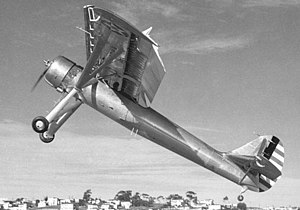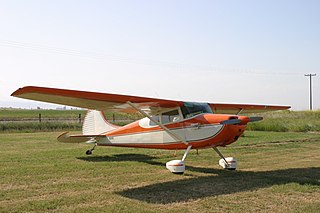
The Cessna 170 is an American light, single-engined, general aviation aircraft produced by the Cessna Aircraft Company between 1948 and 1956.
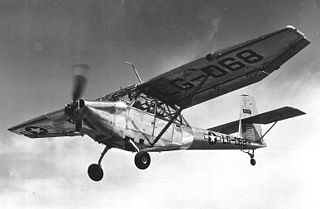
The Stinson L-13 was a US military utility aircraft first flown in 1945. Developed when Stinson was a subsidiary of Consolidated Vultee, rights to it were not included in the 1948 sale of Stinson to Piper. Mass production was therefore undertaken by Convair, which built some 300 of them.
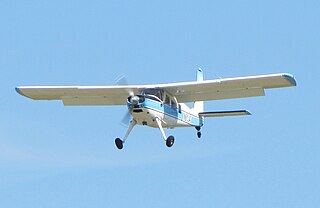
The Helio Courier is a cantilever high-wing light C/STOL utility aircraft designed in 1949.

The Citabria is a light single-engine, two-seat, fixed conventional gear airplane which entered production in the United States in 1964. Designed for flight training, utility and personal use, it is capable of sustaining aerobatic stresses from +5g to -2g. Its name spelled backwards, "airbatic", reflects this.

The Curtiss O-52 Owl was an observation aircraft used by the United States Army Air Corps before and during World War II.

The Aeronca L-3 group of observation and liaison aircraft were used by the United States Army Air Corps in World War II. The L-3 series were adapted from Aeronca's pre-war Tandem Trainer and Chief models.

The 8GCBC Scout is a two-seat, high-wing, single-engined fixed conventional gear general aviation airplane that entered production in the United States in 1974. Designed for personal and commercial use, it is commonly found in utility roles such as bush flying—thanks to its short takeoff and landing (STOL) ability—as well as agriculture, pipeline patrol, and glider and banner towing.
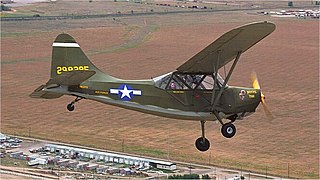
The Stinson L-5 Sentinel was a World War II era liaison aircraft used by all branches of the U.S. military and by the British Royal Air Force. It was produced by the Stinson Aircraft Company. Along with the Stinson L-1 Vigilant, the L-5 was the only other American liaison aircraft of World War II that was purpose-built for military use and had no civilian counterpart. All other military liaison airplanes adopted during World War II were lightly modified "off-the-shelf" civilian models.

The Miles M.38 Messenger is a British four-seat liaison and private owner aircraft built by Miles Aircraft.

The Stinson L-1 Vigilant was a 1940s American light observation aircraft built by the Stinson Aircraft Company at Wayne, Michigan. The aircraft was operated by the United States Army Air Corps as the O-49 until 1942.

The Douglas O-31 was the Douglas Aircraft Company's first monoplane observation straight-wing aircraft used by the United States Army Air Corps.

The Bellanca YO-50 was a United States prototype observation aircraft, built for the United States Army in 1940. Typical for aircraft of its type, it was a high-wing braced monoplane with fixed tailwheel undercarriage and extensive cabin glazing. Its inverted "V" engine made it resemble its German equivalent, the Fieseler Storch.

The Bellanca 19-25 Skyrocket II was a prototype light airplane built in the United States in the 1970s. Despite its advanced design and exceptionally good performance, it never achieved certification or entered production.
The Fletcher FL-23 was an American two-seat liaison or observation aircraft designed and built by the California-based Fletcher Aviation Corporation. It was entered into a competition and lost against the Cessna 305A as a liaison or observation aircraft for the United States Army.

The Kobeseiko Te-Gō was a Japanese two-seat STOL experimental reconnaissance aircraft developed by Kobe Steel in 1942 for service in World War II. In accordance with the Army's request, Professor T. Miki, Osaka Imperial University designed and Kobe Seikojo built the Te-Gō. No "Ki" code number was assigned there to since the project was outside the jurisdiction of the Army Aviation Headquarters.
The Fisher Horizon is a family of Canadian two-seats-in-tandem, conventional landing gear, single-engined, high-wing monoplane kit aircraft designed for construction by amateur builders. The Horizon 1 was inspired by the Aeronca Champion and its later version, the Bellanca Citabria, while the Horizon 2 was inspired by the Cessna O-1 Bird Dog.

The Mississippi State University XV-11A Marvel was an experimental American STOL research aircraft of the 1960s. The MARVEL (Mississippi Aerophysics Research Vehicle with Extended Latitude) was a single-engined pusher monoplane fitted with a boundary layer control system. The first all-composite aircraft, it carried out its initial program of research on behalf of the US Army in the late 1960s, and was rebuilt in the 1980s as a proof-of-concept for a utility aircraft.

The Curtiss O-40 Raven was an American observation aircraft of the 1930s which was built and used in small numbers. A single example of the YO-40, a single-engined Sesquiplane with a retractable undercarriage was built, followed by four examples of a modified monoplane version, the O-40B, which remained in use until 1939.

The Ikarus Kurir is a single-engined high-wing monoplane designed in Yugoslavia for army liaison and air ambulance work from small airfields. Built in large numbers, it served with the Yugoslav Air Force (JRV) until 1972, when it entered civilian use.

The Stearman XOSS was an American biplane observation floatplane developed by Stearman Aircraft for the United States Navy during the late 1930s. Intended to replace the Curtiss SOC Seagull in service aboard battleships, it proved inferior to the Vought OS2U Kingfisher in a fly-off, and did not enter production.
